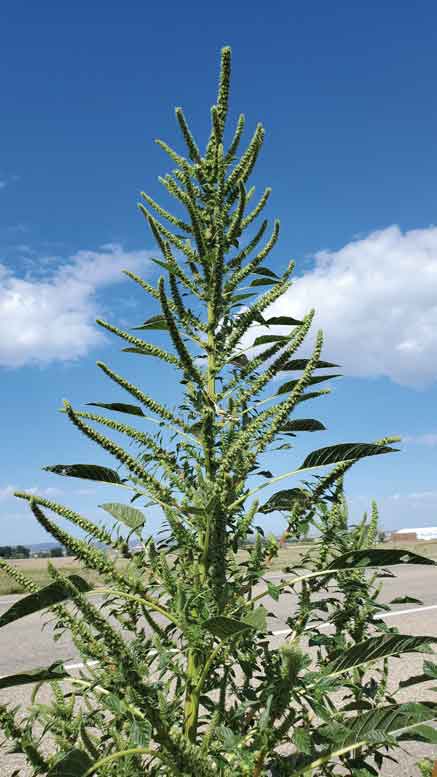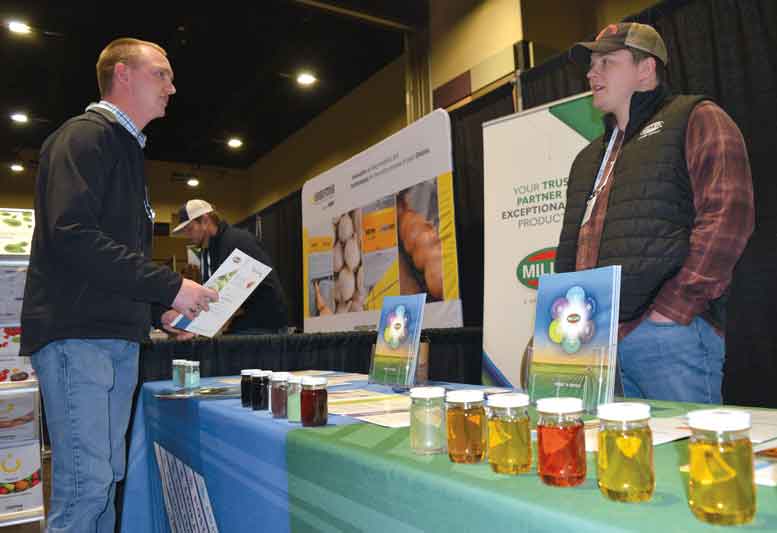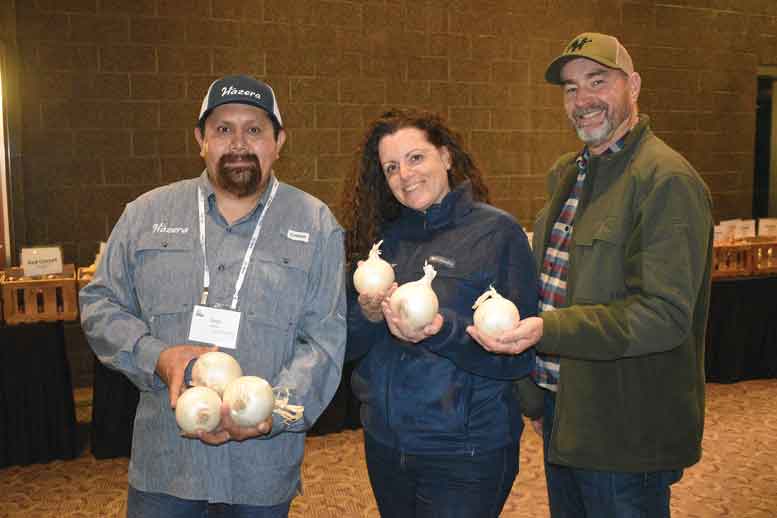|
Click to listen to this article
|
From new invasive weeds to some of the onion industry’s most persistent pests, onion production is never short of challenges. The onion session at the Pacific Northwest Vegetable Association Conference, held Nov. 15-16 in Kennewick, Washington, gave researchers an opportunity to address today’s growing challenges by sharing new data and some important reminders.

Weeds Warning
Joel Felix, an associate professor of weed science at Oregon State University (OSU), took the stage to update growers on what he calls the most anticipated weed in the Pacific Northwest: Palmer amaranth. He is among scientists who have been issuing warnings about the weed’s arrival since 2021, and now that the weed is in the region, he is working to teach growers how to identify and manage it.
Palmer amaranth is a summer annual weed species, native to the southwestern U.S., Mexico and South America. Growers can think of the weed as “redroot pigweed or Powell amaranth on steroids,” Felix said, adding that it has been referred to as “the king of weeds.”

Correct identification is crucial for developing management programs, Felix said. Palmer amaranth has smooth stems; non-wavy, diamond-shaped leaves; petioles longer than leaf blades; and elongated seed heads, up to 24 inches long. Emergence begins after accumulation of more than 350 growing degree days and continues through September. It grows quickly – about 2 or 3 inches per day and up to 10 feet – and a single plant produces more than 250,000 seeds. The weed can be very competitive, and its spread will result in added hand weeding expenses for onion growers, Felix said.
Management recommendations include uprooting plants before seed set, harvesting infested fields last, sanitizing equipment, and using shallow tillage to encourage germination. Felix also recommended using soil-applied Group 15 herbicides such as Dual Magnum or Outlook. Plants found so far are resistant to glyphosate (e.g. Roundup) and possibly Group 2 herbicides.
Felix also added some words of caution about velvetleaf, a weed that is scattered in the Treasure Valley of Idaho and Oregon and is becoming increasingly common. The weed, which emerges from June through October and grows 3 to 8 feet tall, has a stout stem with soft hairs, heart-shaped leaves, and yellow to orange flowers with five petals. It produces abundant seeds that can persist in soil for up to 60 years.

Pre-Emergent Herbicides
Rui Liu, a weed scientist with Washington State University (WSU), followed Felix with a presentation on pre-emergent herbicide options. After reviewing the region’s problematic weeds in onions and reminding growers about herbicide resistance and management, Liu shared an update on a pre-emergent herbicide trial she worked on with WSU’s Tim Waters.
The researchers conducted a field study in Pasco, Washington, to evaluate six pre-emergent herbicides at low and high rates for control of redroot pigweed, puncturevine and lambsquarters. The study also evaluated the products’ safety to the onion crop, and results showed that the tested herbicides had no significant injury on onion, except for Dacthal (3-5 percent).

Overall, weed control decreased as the season progressed. Liu said Dacthal provided excellent control of puncturevine throughout the season, at 92- 95 percent control. In comparison, the rest of the treatments lacked sufficient control of puncturevine at the end of the season, at 0-40 percent control. The percentage of control on redroot pigweed did not differ between low and high rates of the herbicides, ranging from 65 percent to 85 percent, with the exception of Nortron at 8 fl. oz. per acre, which showed 27 percent control. Liu reported similar results for lambsquarters.
All treatments had more medium grade onion yield, except for Dacthal at the lower rate and Dual Magnum at the higher rate. The onion marketable yield did not differ significantly among all treatments.

Onion Thrips
OSU Malheur Experiment Station Director, Stuart Reitz, kicked off the second half of the session with a refresher course on onion thrips control. He said onion thrips remain the single most important onion pest because of their direct feeding damage and transmission of Iris yellow spot virus, both of which reduce the size and quality of bulbs. Thrips populations are generally much higher in red onions than yellow onions.
Because insecticides remain a key part of thrips management, Reitz wanted to address three big-picture questions: 1) How long do I need to spray over the season? 2) How often do I need to spray? 3) What do I need to spray?

Onion thrips populations in the Pacific Northwest build up rapidly and peak in July. These peak populations have the greatest impact on yields, so maintaining spray programs during that time of the season is critical, Reitz said. Minimizing the time between insecticide applications helps keep the crop size profiles as large as possible. As for product selection, there are only a few effective insecticides for onion thrips, so growers need to be strategic in selecting which ones to use. Tank mixing insecticides just because one is not working well turns out not to be a good strategy. Adding a second insecticide is not going to make the poor performer work better. It’s better to put the poor performer away and find an alternative.

Below-Ground Pests
Reitz followed his thrips talk with a second presentation, this one addressing below-ground pests growers should be concerned about, including seedcorn maggot, onion maggot, wireworms and bulb mites. These soil-borne pests are most problematic early in the growing season. Feeding on the developing root systems of young onions can lead to stunting of the plant or often kill the plant, leading to stand losses. Damage from seedcorn maggots and onion maggots can be especially intense in springs with wet and cool weather, as the onions grow slowly while the maggots are still able to develop.
Likewise, damage from bulb mites seems to be worse in cold, wet springs, especially in fields with high amounts of organic material in the soil. In addition to early-season damage, wireworms can also burrow into bulbs later in the season.

There are no effective rescue treatments for these pests, so growers need to take preventive approaches, Reitz said. Insecticide seed treatments that contain spinosad provide protection against maggots, and those that contain neonicotinoids provide protection against wireworms. Little is known about effective miticides for bulb mites, although the IR-4 program is currently sponsoring research in that area. Reitz recommended growers not plant back-to-back onions and not plant onions immediately after a long-term crop, like hay or pasture, where wireworm populations are likely to be high.

